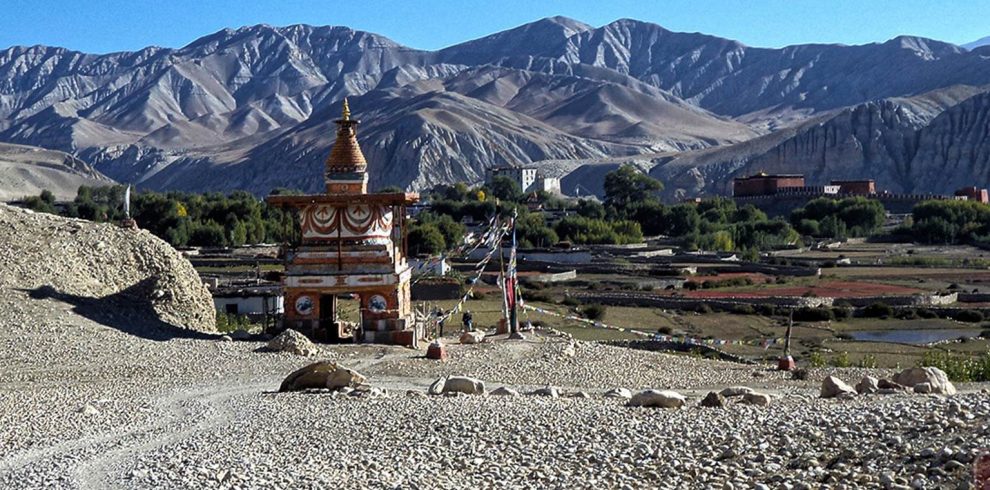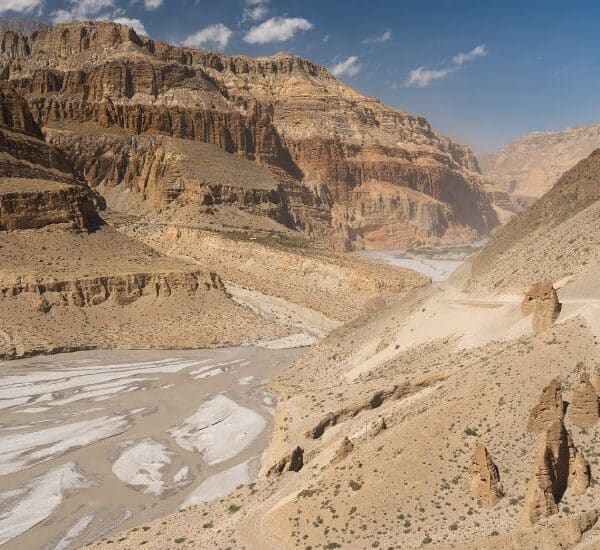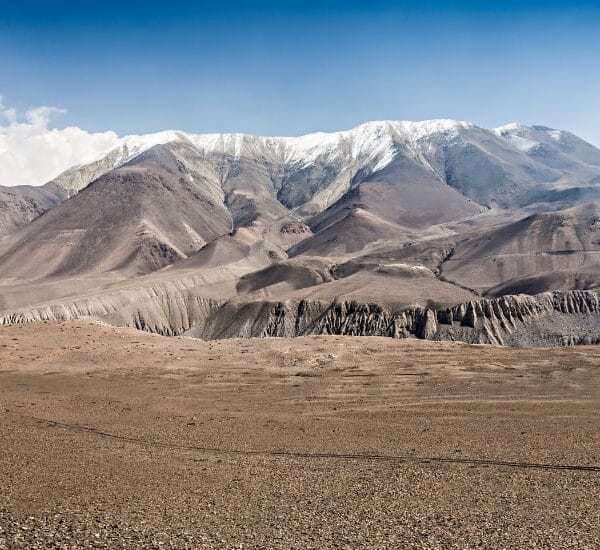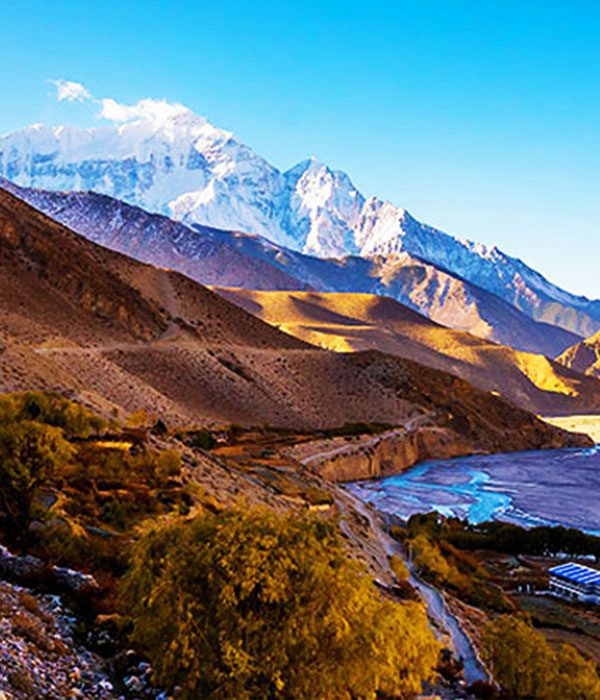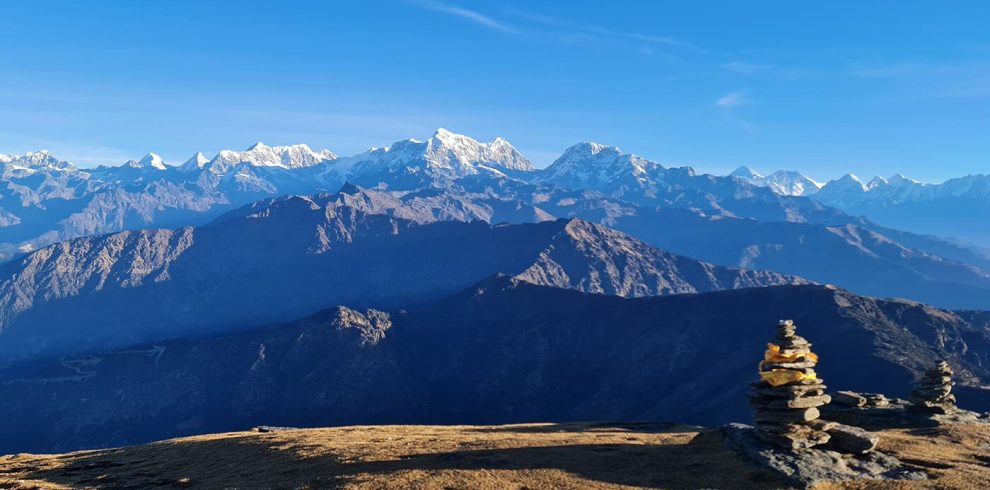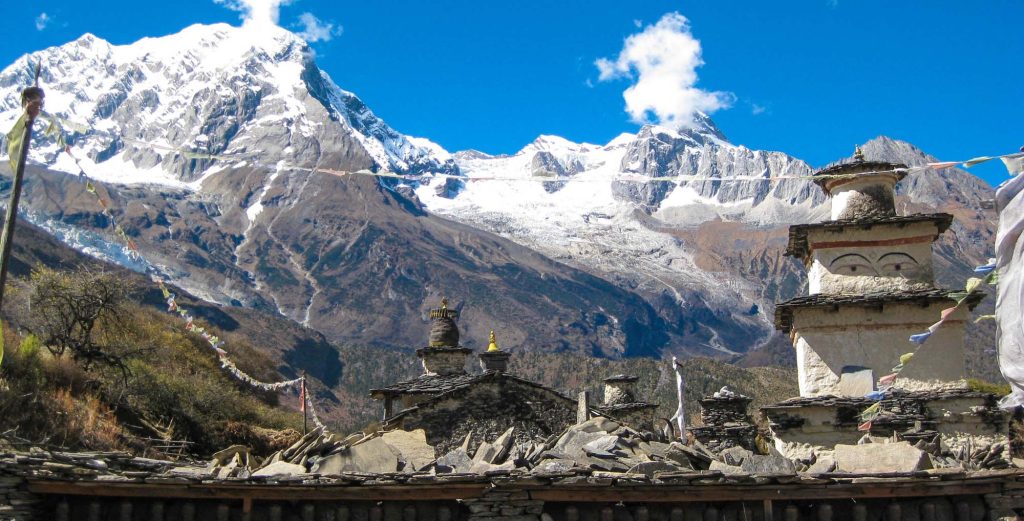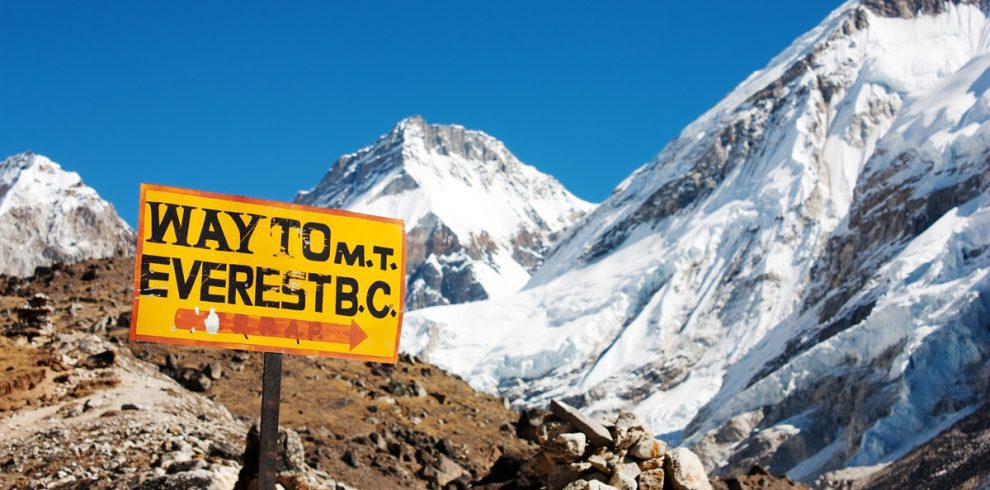Upper Mustang Trek Overview
Upper Mustang Trek, also well-known as Lo-Manthang Trekking, offers a unique opportunity to experience the fantastic beauty of the Himalayan desert and its unusual landscape. The Upper Mustang Trek covers the northern two-thirds of the Mustang district in the Dhaulagiri Zone of Nepal. The main attraction of the Upper Mustang Trek is the walled city of Lo-Manthang. This trek includes visits to natural caves, chortens, monasteries, palaces, and alpine villages with friendly Bhotiya people.
The Upper Mustang Trek consists of two distinct regions: the southern part and the northern part, where the language, culture, and traditions are similar to those of the Tibetan people. The Upper Mustang trek was opened to foreigners in 1992. The trek to Lo-Manthang takes you through high-altitude desert country, climbing in and out of the massive-sided valley of the Kali Gandaki.
During this Upper Mustang Trek, you’ll witness magnificent views of mountains and peaks along the trek, with the chance to reach the world’s deepest river gorge in the Kali Gandaki River. The trek also includes a holy pilgrimage to Muktinath, a sacred place for both Hindu and Buddhist followers, as well as exploring the Lo-Manthang valley, Kagbeni village, and encountering a variety of flora and fauna, among other rewarding experiences.
We begin our 17-day excursion in Kathmandu with visits to UNESCO World Heritage sites before heading to the most popularly known Mustang Trekking.
We offers an ideal budget package trip to Mustang at the best cost, making your trip memorable.
Upper Mustang Trek Highlights
- Discover the ancient Tibetan Buddhist culture in the hidden kingdom of Lo Mustang, with its centuries-old monasteries, chortens, and traditional villages.
- Trek through the unique terrain of the Mustang region, characterized by red and orange cliffs, deep gorges, and the barren yet striking Tibetan Plateau.
- Visit the walled city of Lo Manthang, a cultural and historical gem, where time seems to stand still.
- : Reach altitudes up to 4,200 meters, with stunning views from Mustang La and other high passes, offering a thrilling experience for both beginners and seasoned trekkers.
- Enjoy the trek during the mild and dry spring and autumn seasons, with clear skies and comfortable temperatures ideal for trekking.
- Stay in traditional tea houses or luxury lodges, with meals featuring hearty local dishes like Dal Bhat and fresh vegetables.
- Experience the dramatic desert-like terrain and stunning views of the Kali Gandaki River gorge.
- Trek to Muktinath, a sacred site for both Hindu and Buddhist followers, and explore Kagbeni village.
- Trek through the regions of Mustang, which were opened to foreigners in 1992, offering a glimpse into an ancient and culturally rich area.
Upper Mustang Trek Itinerary
Upon your arrival at Tribhuvan International Airport, we offer you a pick-up facility from the airport and manage your stay at the most comfortable hotel in the city. You get to meet the team of trekkers, and together we prepare for the trek.
Today would be the most exhilarating day, where you will be introduced to the most pious Hindu and Buddhist religious places listed as UNESCO World Heritage sites. You will explore the mysticism surrounding Pashupatinath temple, Boudhanath stupa, Patan Durbar Square, and Swayambhunath stupa. Overnight stay in Kathmandu.
After breakfast, we leave for Pokhara, also known as The Lake City due to its numerous lakes. On the way to Pokhara, we are rewarded with magnificent views of the Himalayas, including Dhaulagiri (8,167m), Manaslu (8,156m), Machhapuchhre (6,993m), the five peaks of Annapurna, and others. Upon arrival, we check into our hotel and take a rest. We enjoy boating on Fewa Lake and strolling in the city’s quaint streets. Overnight stay in Pokhara.
After getting our permits checked, our trek begins along the Kali Gandaki River. We walk on sand amidst heavy wind before ascending a hill. We reach the Tangbe Village and admire its narrow alleyways, white-washed houses, barley and buckwheat fields, and apple orchards. We continue our walk, passing through the next village, crossing a river, and finally reaching Chele Village. Overnight stay in Chele.
Our trek today will be more challenging as we cross two passes: Taklam La Pass (3,624m) and Dajori La Pass (3,735m). On the way, we enjoy outstanding views of Tilicho, Yakawa Kang, and Damodar Danda and pass by the Ramchung Cave. We continue our trek, reaching Samar Village and then a ridge. Finally, we reach Syangbochen. Overnight stay in Syangbochen.
We trek to the Yamda La Pass (3,850m), passing by a few tea houses, Chortens, and beautiful villages. We continue through poplar forests and barley fields, reaching Nyi Pass (4,010m). From there, we head towards Ghaymi, one of the largest villages in the Lo region, surrounded by fields. Overnight stay in Ghaymi.
Our trek today begins with a challenging and often slippery trail. We cross a suspension bridge over the Ghaymi Khola and continue our trek. The path is beautiful, with mani walls along the trail. We cross the Tsarang La Pass (3,870m) and reach Tsarang village, situated atop Charang Chu canyon with a huge fortress and a red gompa towards its east. Overnight stay in Charang.
We begin our trek by passing through a canyon and crossing a river before beginning our uphill trek to Lo La Pass (3,950m). From the top of the pass, we observe the beautiful Lo-Manthang village. We descend to Lo-Manthang, a walled village with stunning views of the Himalayas, including Nilgiri, Tilicho, Annapurna I, Bhrikuti Peak, and Damodar Kunda (pond). Overnight stay in Lo-Manthang.
Lo-Manthang is known as the walled town of the remote Upper Mustang region of Nepal. We spend our day touring three major gompas of the town: Jhampa, Thupchen, and Chhoeda. All of these gompas have undergone expert restoration over the last two decades. We can also trek to Tingkhar, a beautiful village located northwest of Lo-Manthang. Overnight stay in Lo-Manthang.
We take a different route on our return from Lo-Manthang, passing through Gyakar village, which houses the century-old Ghar Gompa with beautiful rock paintings. According to local beliefs, any wish made at the Gompa will be fulfilled. We continue our trek to Drakmar. Overnight stay in Drakmar.
We start our trek early in the morning to avoid the heavy wind. The trail passes through dry plateaus and fields before reaching Ghiling. The walk can be challenging due to the strong winds, but we are rewarded with beautiful views of the Dhaulagiri and Nilgiri mountains. Overnight stay in Ghiling.
We retrace our steps along the same trail used earlier, heading towards Chhuksang. On the way, we enjoy the stunning views of the Himalayas. Overnight stay in Chhuksang.
Today is the final day of our trek, making it a long one. After trekking for a while, we end our Mustang trails and join the Annapurna Circuit trails. Overnight stay in Jomsom.
We take an early morning flight to Pokhara, passing through a gorge between the Annapurna and Dhaulagiri mountains. This flight itself is an amazing experience. After arriving in Pokhara, we spend the rest of the day at leisure. Overnight stay in Pokhara.
After breakfast, we say goodbye to the beautiful northern skyline of Pokhara and drive towards Kathmandu. This journey takes us along riverbanks with wonderful views of terraced hills and the rural Nepalese lifestyle. Upon arrival in Kathmandu, we rest and then enjoy a farewell dinner (Nepali Food) to celebrate the successful completion of our journey. Overnight stay in Kathmandu.
Includes/Excludes
Cost Includes
- Pick up and drop off from and to International airport.
- 3 nights hotel in Kathmandu (first two nights and last one night).
- 2 nights hotel in Pokhara.
- Annapurna Conservation Park permit.
- TIMS Card (Trekker’s Information Management System).
- Upper Mustang special permits.
- One porter for each two people.
- Accommodation in tea houses twin sharing (private room/ Shared bathroom).
- 3 Meals a day – breakfast, lunch, Dinner during the trek (Anything from the menu).
- Flight tickets (Pokhara–Jomsom-Pokhara).
- Sightseeing tour car A/C with driver.
- Farewell dinner at Nepalese cultural restaurant after the trek in Kathmandu.
- All taxes and Company service charges.
Cost Excludes
- Nepal Visa fee (bring accurate USD cash and two passport size photographs).
- International airfare to and from Kathmandu.
- Lunch and Dinner in Kathmandu.
- Monument sites entrance fees while sightseeing in Kathmandu.
- Excess baggage charges.
- Extra night accommodation in Kathmandu because of early arrival, late departure, and earlier return from the mountain (due to any reason) than the scheduled itinerary.
- Travel and rescue insurance.
- Personal expenses (phone calls, internet / Wi-Fi, laundry, bar bills - tea/coffee, hot chocolate, juice, beer, battery recharge, extra porters, bottled or boiled water, shower etc.).
- Tips for guides and porters (Tipping is expected, but not compulsory).
FAQs on Upper Mustang Trek
The pre-monsoon (March to May) and post-monsoon (September to November) seasons are the ideal times to traverse Upper Mustang. These times of calm weather and bright skies offer the nicest views of the surrounding landscapes. The area is accessible all year round because of its location in the Himalayan rain shadow, which results in less rainfall even during the monsoon season. Still, the recommended seasons provide the most pleasant trekking conditions.
Upper Mustang was restricted to preserve its unique culture and environment. The region’s remote location and political sensitivities with Tibet also contributed to its restricted access. It was only opened to trekkers in 1992.
The Upper Mustang trek is more expensive due to the restricted area permit, which costs $500 for the first ten days. Additionally, the remote location and limited infrastructure increase the cost of logistics and supplies.
Absolutely! A private trek in Upper Mustang is possible and a popular choice for those looking to tailor their experience. By opting for a private trek, you can enjoy a more personalized journey, with the flexibility to set your own pace and explore the region with a guide and porter dedicated to your needs. Trekking agencies in Nepal can easily arrange this, ensuring you have the needed support and expertise.
The Upper Mustang trek is moderately challenging, with the main difficulties stemming from the high altitude, rugged trails, and strong winds that sweep through the region. The highest point on the trek reaches about 4,200 meters (13,780 feet), which can be challenging for those not acclimatized to such elevations. However, with proper preparation, a good level of fitness, and adequate acclimatization, most trekkers find the journey both manageable and rewarding.
The Upper Mustang trek typically spans 15 to 17 days, depending on your itinerary. This timeframe includes several days for acclimatization, which is essential due to the high altitude and ample time to explore the cultural and historical sites in the region, particularly in the ancient walled city of Lo Manthang.
Although trekking without a guide is possible, it is advised. A guide can assure safety, help with navigation, and offer cultural insights—especially in this far-flung area.
The best seasons for trekking in Upper Mustang are during the pre-monsoon (March to May) and post-monsoon (September to November) periods when the weather is stable and visibility is clear.
The spring (March through May) and fall (September through November) seasons are the ideal times to visit Upper Mustang. These are the best times to go hiking because of the steady weather, bright skies, and comfortable temperatures. Conversely, winter brings intense cold and snow, which complicates and limits the trek.
The Upper Mustang trek can cost between $1,500 and $2,500 per person, depending on factors such as the length of the trek, accommodations, and whether you’re trekking with a guide or independently.
The Upper Mustang trek typically starts in Jomsom, a town in the Kali Gandaki Valley accessible by flight from Pokhara.
The altitude of the Upper Mustang ranges from about 2,800 meters (9,186 feet) at Kagbeni to over 4,200 meters (13,780 feet) at the highest passes along the trek.
The restricted area permit for Upper Mustang costs $500 for the first ten days and $50 for each additional day. An Annapurna Conservation Area Project (ACAP) permit costs $30.
In Upper Mustang, the primary language spoken is Tibetan, reflecting the region’s deep cultural ties to Tibet. Although some residents also speak Nepali, English is not widely spoken, especially in the more isolated places. Knowing a few simple words in Tibetan or Nepali is beneficial, or you can go with a guide who can help with communication.
Upper Mustang is a haven for wildlife enthusiasts, home to several fascinating species. Among them are the elusive snow leopard, the agile blue sheep, and the majestic Himalayan griffon vulture. The area also boasts a variety of bird species, making it an excellent spot for birdwatchers.
Upper Mustang is often referred to as the “Last Forbidden Kingdom.” This name reflects its historical status as a restricted region, once part of the isolated Kingdom of Lo, where traditions and customs have been preserved almost unchanged for centuries.
The distance from Kathmandu to Mustang (Jomsom) is approximately 375 kilometers (233 miles) by air and road. The journey typically involves a flight to Pokhara and another flight to Jomsom.
The weather in Upper Mustang is generally dry, with temperatures ranging from excellent to cold, depending on the season. Because the area is under the Himalayan rain shadow, it receives minimal rainfall.
Upper Mustang was once part of the ancient Kingdom of Lo, an autonomous region with strong cultural ties to Tibet. It remained isolated and largely unknown to the outside world until it was opened to trekkers in 1992. The area is known for its unique culture, stunning landscapes, and ancient monasteries.
The walled capital of the old Kingdom of Lo, Lo Manthang, is the most well-known town in Upper Mustang. Some more noteworthy towns are Tsarang, Chele, and Kagbeni.
The beauty of Upper Mustang lies in its stark and dramatic landscapes, which are unlike any other in Nepal. The region’s desert-like terrain, with its multicolored rock formations and deep ravines, contrasts sharply with the lower Annapurna region’s lush green valleys and snow-capped peaks.
Beyond its physical beauty, Upper Mustang is also culturally rich. Ancient monasteries, caves, and the walled city of Lo Manthang offer glimpses into a way of life that has remained unchanged for centuries.

